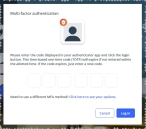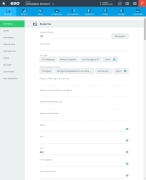Oklahoma trauma triage
Trauma is a tissue injury that occurs as a as a result of violence or an accident, which may result in wounds, broken bones, or internal organ damage.Triage is an assessment of the physiology and anatomy of the patient's injury, the mechanism of the injury, and special patient considerations.
Oklahoma’s paramedics, ambulance services (air and ground) and hospitals all participate in the statewide system of trauma care that delivers critically ill or injured people to medical facilities as fast as possible. If necessary, EMS will bypass closer hospitals or facilities that may not be able to provide immediate care. to reach a trauma center in time.
-
 (If you have not done so already) Access the EHR module in the ESO Suite.
(If you have not done so already) Access the EHR module in the ESO Suite.
-
Do one of the following.
-
(If you are already working in the ESO Suite) Click the Home icon in the upper left corner of the screen.
-
 (If you have not yet logged in) Log in to the ESO Suite.
(If you have not yet logged in) Log in to the ESO Suite.
-
In a web browser, go to https://www.esosuite.net/EsoSuite.
The ESO Suite login screen appears.
-
Enter your user name, password, and agency name, then click Let's Go.
If MFA is enabled, the Multi-factor authentication dialog box appears, displaying one or more methods you can use to verify your login credentials. The number of methods that appear in the dialog box depends on what MFA methods your ESO Suite administrators enabled in the Admin module.

Click graphics
to open them.Information on enabling MFA and specific MFA methods is available in the Admin module online help, in Configure multiple-factor authentication.
Note: If your ESO Suite administrators have disabled MFA ("opted-out"), this dialog does not appear.
-
(If the Multi-factor authentication dialog box appears) Depending on which buttons appear in the dialog box, verify your login in one of the following ways.
 With an authenticator application.
With an authenticator application.
-
Click MFA verification via authenticator app.
The dialog box updates with boxes for entering the numbers of the authentication code, and the ESO Suite sends an authentication code to the authenticator application installed on your device.
-
Open your authenticator application and note the authentication code currently displayed.
-
Enter the authentication code displayed in the authenticator application.
-
Click Log In.
 With a text message (SMS).
With a text message (SMS).
-
Click MFA verification via SMS.
The dialog box updates with boxes for entering the numbers of the authentication code, and the ESO Suite sends an authentication code to the phone number recorded in your PM records and identified with MFA codes.
-
Enter the authentication code sent to your MFA-registered phone number.
-
Click Log In.
 With an email message.
With an email message.
-
Click MFA verification via email.
The dialog box updates with boxes for entering the numbers of the authentication code, and the ESO Suite sends an authentication code to your agency or department email address, recorded in your PM records.
-
Enter the authentication code sent to your agency or department email address.
-
Click Log In.
-
-
The ESO Suite landing screen appears.

Click graphics
to open them.Note: If MFA is enabled, you can access and manage your MFA options through the PM module, on the Settings > Account page, as described in Manage a user account. If your agency or department has enabled MFA but has not purchased the full-featured version of the PM module, you can access your own MFA settings by clicking Change my Multi-Factor Authentication settings on the landing screen, then using the Settings > Account page that appears. If your agency has not enabled MFA, the Change my Multi-Factor Authentication settings link does not appear on the landing screen.
-
-
On the top side of the home screen, click EHR.
Tip: If your screen or browser window is too narrow to display all your agency's ESO Suite module icons, an options icon appears on the right side of the icon bar. If you click the options icon, a menu appears containing additional module icons.
The EHR screen appears, displaying a list of patient records in the EHR module. The most-recent records appear at the top of the list.
Different record status icons can appear in the list.
Icon Status Unlocked/DraftThe patient record exists in the ESO Suite database, and all crew members listed in the patient record may edit all fields in the record. ESO Suite administrators and personnel with security roles of either
EHR SupervisororEHR Managercan edit non-clinical fields.MobileThe patient record exists on the mobile device, and has not been synchronized with the ESO Suite database. ESO Suite administrators, personnel with security roles of either
EHR SupervisororEHR Manager, and all crew members listed in the patient record can only access a print view of the record.Once the Mobile record synchronizes with the ESO Suite database. the record reflects its current status.
LockedThe patient record exists in the ESO Suite database, and is locked. Only non-clinical fields can be edited by crew members listed in the patient record, ESO Suite administrators and personnel with security roles of either
EHR SupervisororEHR Manager.
-
-
 (If you have not done so already) Add a new patient record, or search for the existing patient record you want to work with.
(If you have not done so already) Add a new patient record, or search for the existing patient record you want to work with.
Information on adding or opening a patient record is available in Add a patient record and Search for a patient record.
The patient record opens and displays the Incident tab, with the Response bookmark selected in the left pane. Fields appear in the right pane for specifying basic information about the incident
If you manually created a new patient record, the Incident Number and State Tracking Number fields populate automatically with ESO Suite-assigned values. You must enter data in all other required fields.
If you imported data from a CAD system, the Incident Number field populates with the data from that source. Other fields in the EHR module may also populate from these sources, depending on what data was recorded in them before the data was imported into the EHR module.
-
At the top of the page, click the Forms tab.
The contents of the Forms tab appear, listing all the forms your ESO Suite administrator has enabled in the Admin module.
-
Click Oklahoma Trauma Triage.
The Oklahoma Trauma Triage dialog box appears, with the Trauma Triage bookmark selected in the left pane.
-
 Identify the triage priority of the patient.
Identify the triage priority of the patient.
Trauma triage is the use of trauma assessment for prioritizing of patients for treatment or transport, according to their severity of injury. Criteria for trauma triage are based on physiological parameters, specific anatomical injuries, and the underlying mechanism of injury.
-
For Trauma Triage Criteria, click the list icon to the right of the field, select all the appropriate options from the menu that appears, then click OK or click outside the menu to list all injuries or health conditions the patient is suffering related to the incident
Example: Blunt trauma, penetrating injuries, respiratory compromise
-
For Patient Priority Status, click the field or the list icon to the right of the field, then select the appropriate single option from the menu that appears to indicate what priority level the patient has for treatment.
-
Priority 1 trauma patients have blunt or penetrating injury causing physiological abnormalities or significant anatomical injuries. These patients have time-sensitive injuries requiring the resources of a Level I or II Trauma Center.
-
Priority 2 trauma patients who have potentially time sensitive injuries because of a high energy event or single system injury. These patients do not have physiological abnormalities or significant anatomical injuries and can be transported to a trauma facility with the resources to perform a trauma evaluation and provide appropriate care for their injury.
-
Priority 3 trauma patients do not have physiological instability, altered mentation, neurological deficit, or significant anatomical or single system injury that have been involved in a low energy event. These patients may be evaluated and treated at their hospital of choice or the closest appropriate hospital.
-
-
-
 Communicate with TReC.
Communicate with TReC.
TReC establishes that ambulance services transporting pre-hospital patients or transferring patients’ inter-facility must contact the Trauma Transfer and Referral Center if their destination hospital is within:
-
Oklahoma County or communities that are contiguous to it including Mustang, Norman and Yukon. These are Oklahoma Trauma Regions 6 and 8.
-
Tulsa County. This is Oklahoma Trauma Region 7.
Pre-hospital patients or transferring patients inter-facility must contact TReC before entering into these counties and communities, to ensure patients go directly to the most appropriate facility, reduce over-triage and under-triage, preserve highest-level resources for the most severely injured. and help to limit demands on scarce specialists.
-
In the left pane, click the Trauma Referral Center bookmark.
The right pane scrolls down to the top of the Trauma Referral Center section of the page.
-
For Trauma Referral Center (TReC) Notified, click Yes or No to indicate whether or not EMS requested a referral to an appropriate medical facility for the patient.
If you click Yes, the TReC Tracking Number field appears.
-
(If it appears) In TReC Tracking Number, type the number provided by TReC, to associate with the patient's record and facility destination.
-
For Destination Referred by TReC, click Yes or No to indicate whether or not the patient was referred to a specific medical facility by TReC.
-
-
Click OK.
The dialog box closes, and a green triangle appears in the upper right corner of the form button, to indicate that data exists in this form.











